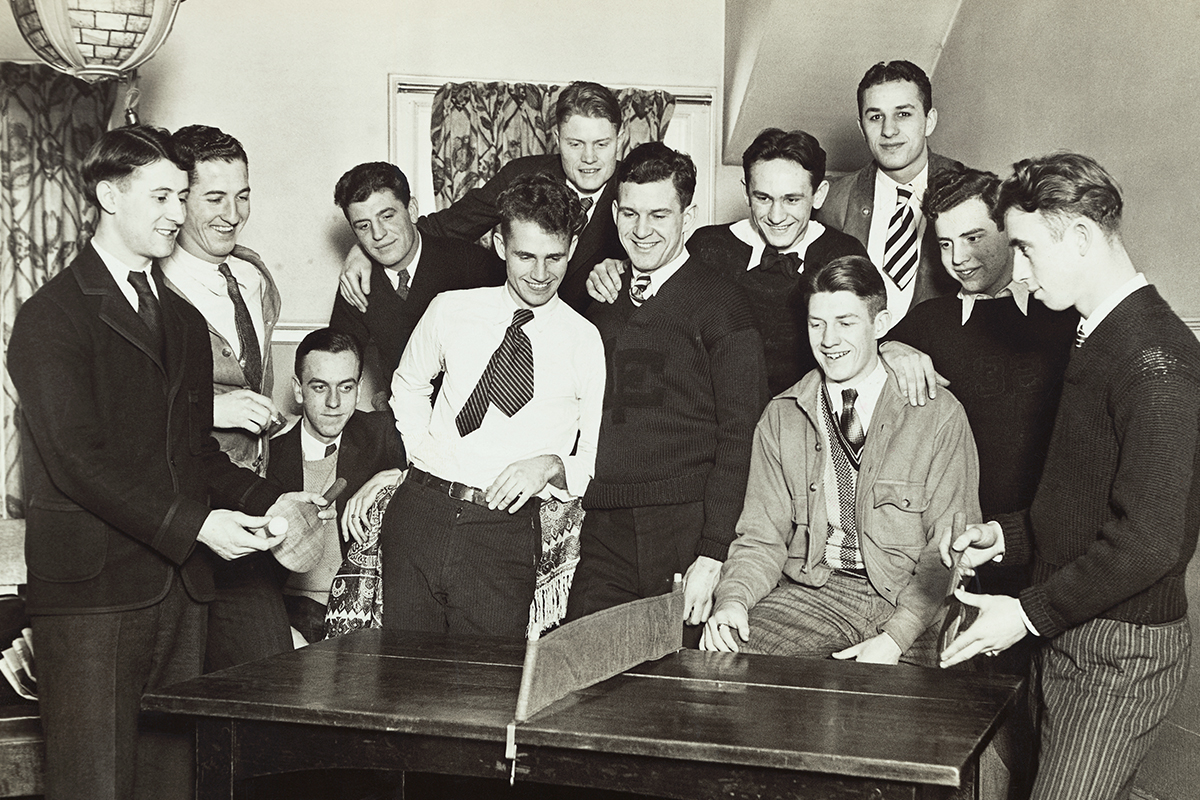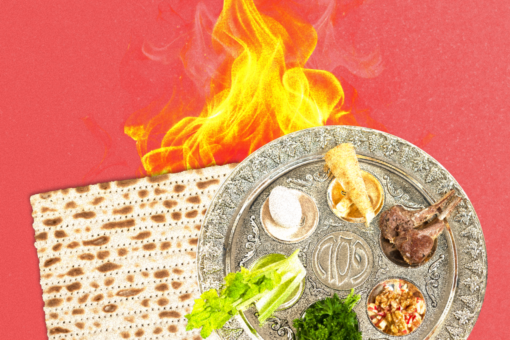Louis Marshall had little patience for Greek life. In a 1928 letter to the president of Tau Epsilon Phi, a Jewish fraternity, he called frats “an absurd exhibition of infantilism. They involve criminal waste of time. For grown men to make them the center of thought and activity seems to me to be inexpressibly silly…Booze and sex and their concomitants seem to constitute the be-all and end-all of their mental lucubrations. Any movement which would forbid secret fraternities in our colleges and universities would have my whole-hearted support.”
Marshall, a lawyer and co-founder of the American Jewish Committee, was writing during a decade when Greek organizations were reaching peak popularity and influence on college campuses, and when most excluded Jews and people of color. Many had Aryan-only clauses (seriously) or just de facto excluded non-WASPs from the recruitment process.
Barred either in letter or in practice, Jews began to form their own Greek organizations around the turn of the 20th century; Black fraternities and sororities began forming around the same time. Marshall thought anti-Semitic exclusion was legally and morally wrong, and believed Jews and other minorities should be allowed into Greek life — but “personally,” he wrote, “I think it would be a blessing in disguise if our Jewish students were deprived of this great boon.”
Marshall’s dream of a movement to “forbid” fraternities has found an echo in today’s growing national calls to abolish Greek life, prompted by this summer’s national racial uprising in the wake of police murders of unarmed Black people. Students, many former pledges themselves, have borrowed language from Black-led organizing to abolish police and prisons — as well as the sensibility that reforming historically discriminatory institutions is not sufficient — to demand that Greek members disaffiliate and chapters dissolve.
The #AbolishGreekLife movement uses Instagram testimonials to share stories of racism, sexism, transphobia, and sexual violence rampant in historically white Greek organizations. Fraternities and sororities are still mostly white, run by rather unaccountable national organizations, and reticent to change their ways of archaic gender roles, to name a few of the movement’s recurring qualms. Rather than trying to change these organizations from within, students say, Greek life should be dismantled.
Though once excluded from white Greek life, Jewish fraternities and sororities too have had their share of racist scandals, and thus find themselves in an interesting position in relation to the #AbolishGreekLife movement. It turns out American Jews have been arguing over the merits of Greek life — whether to join it, integrate it, or burn it down — pretty much since the first Jewish fraternity, Phi Epsilon Pi, was founded at Yale in 1895. These passionate, sometimes nasty, arguments are a fascinating lens into the evolution of Jewish whiteness, the price of assimilation, and the changing role of explicitly Jewish spaces on campus.
As this summer’s uprising prompts deep reflection on racism and exclusion within the Jewish community, the history of Jewish Greek life in particular complicates comfortable stories about Jewish involvement in the Civil Rights Movement, challenging us to look at how Jews reacted to integrating our own spaces, not just Montgomery bus terminals or Mississippi voting booths.
Jewish Greek life emerged as a direct response to anti-Semitic exclusion on campus: During the first half of the 20th century, Jewish sorority houses were often the only place young Jewish women could live on campus when barred from boarding houses, Jewish fraternities the only places Jewish men could socialize when prohibited from joining other clubs. Jewish fraternities participated in the ADL’s Fireside Discussion Groups Project, which in the late 1930s sent out pamphlet guides about how to refute blood libel tropes and other common anti-Semitic conspiracies, and in the face of hiring discrimination, provided key access to a network of successful alumni. Jewish fraternities and sororities also served as a bastion against intermarriage. They acted, historian Marianne Sanua Dalit told me, “as a giant national Jewish matchmaking service. An amazing number of Jews met their spouses through the Jewish Greek system.”
Even as they were born of anti-Semitic discrimination, “[Jewish sororities] had such a desire to find acceptance in their non-Jewish peers,” historian Shira Kohn told me. The sororities petitioned for entry to the National Panhellenic Council (NPC), white sororities’ governing body, every year between 1917 and 1946. They were finally allowed in 1947, nearly a generation after Jewish fraternities were allowed into the male equivalent. “[Jewish sororities’] anxiety about perceptions of Jewish inferiority drove them to be discriminatory against some Jewish women who were trying to become members,” Kohn says. “If someone was seen as being too loud, too stereotypically Jewish, gesticulating too much, seen as being too loose with men, all these were grounds for not accepting a woman as pledge.”
Jewish Greek life was often a site of vicious intercommunal bashing, precisely because it was an “important means of acceptance and acculturation into upper- and upper-middle-class American norms,” Sanua Dalit writes in a 2000 article. The wealthy, German Jewish boys who founded Zeta Beta Tau, ZBT, in 1898 as a Zionist reading and social group would’ve sneered at Alpha Epsilon Pi, AEPi, which began as a frat for night school students at NYU studying accounting. In the 1930s and ‘40s, Jewish women at the University of Missouri got the ADL involved when they alleged that the campus ZBT chapter was forbidding its members from dating Jewish women, charging them five dollars if they broke the rule. “What was really incredible was the self-hatred, the anti-Semitism that they internalized,” Sanua Dalit says.
The debates that roiled Jewish Greek life most viciously, though, were over race and civil rights. After the 1954 Brown v. Board of Education ruling, tension over integrating Jewish fraternities and sororities peaked. Fraternities and sororities are “places that become hotbeds for debates about whether minorities can be exclusive,” Kohn says. When Jewish sororities at Syracuse and Hunter College asked their national organizations if they could integrate in the late 1950s and early 1960s, the higher-ups refused. Kohn says this came as much from a desire to exclude African American students as a deep desire for self-preservation. “What [the national offices said] is ‘if Jewish organizations are the first to integrate, we are going to be in so much trouble with NPC. Jews cannot be on the vanguard of this moment.’”
“There’s constantly been a tension between the national organization and the kids on the campus,” Sanua Dalit explained. (Sound familiar?) “And there were many cases where the undergrads insisted on pledging an African American member and the national organization disaffiliated the chapter.”
A few Jewish chapters succeeded in challenging their national organizations. In 1950, Phi Epsilon Pi threatened to expel its UConn chapter for pledging Alfred Rogers, a Black student and varsity football player. But students organized over a dozen other chapters nationwide to threaten mass resignations, forcing Phi Epsilon Pi to adopt a resolution in December 1950 that it would not discriminate on the basis of color. Jewish civil rights martyr Michael Schwnerner, killed alongside James Chaney and Andrew Goodman when registering Black Mississippi voters in 1964, was eulogized by his AEPi brother after the two met in a campaign to racially integrate their pledge class.
Still, racially integrating the proverbial burning frat house didn’t appeal to all students. “When the ‘60s came and that general campus rebellion [too], Jewish and non-Jewish students just decided frats were irrelevant and they walked off, leaving chapter houses empty,” Sanua Dalit says. In fact, when Phi Epsilon Pi brothers at Columbia University abandoned their house to join anti-war and civil rights demonstrators in 1968, Students for a Democratic Society (SDS) took over the building to use it as their campus headquarters.
This summer, like in 1968, thousands have been protesting in the streets and demanding a national reckoning with systemic racism –– though students today aren’t necessarily occupying frat buildings. Besides, what remains of Jewish Greek life would be totally unrecognizable to Louis Marshall and other early critics: These days, white Jews are considered white and are widely recruited into non-Jewish Greek organizations. Many of the early Jewish fraternities and sororities have dissolved or abandoned their Jewishness, and the remaining Jewish Greek chapters tend to resemble the rest of Solo Cup, American college culture, save the occasional fundraiser for Israel, boozy Shabbat dinner, or, unfortunately, a swastika graffiti’d on an AEPi house.
Historically white Greek life seems less and less defensible in the face of accusations of systemic racism and exclusion, and the slow, piecemeal pace of any potential reforms. Even so, Jewish fraternities and sororities seem to be pledging (sorry) ahead.
In an email, AEPhi’s national resident dismissed the idea that recent qualms with white Greek life apply to Jewish chapters. “AEPhi is in a unique position with regards to the abolish movement,” she wrote. “[We] have never had any exclusionary clauses in our documents. We were founded 110 years ago when Jewish women were not permitted to join other sororities. We were created as a home for Jewish women so that they could have the same sisterhood experiences as the other groups in a Jewish setting. Here we are 110 years later.”
Header image: the Phi Pi Epsilon frat house in Lake Forest, Illinois. Photo by George Rinhart/Corbis via Getty Images.



